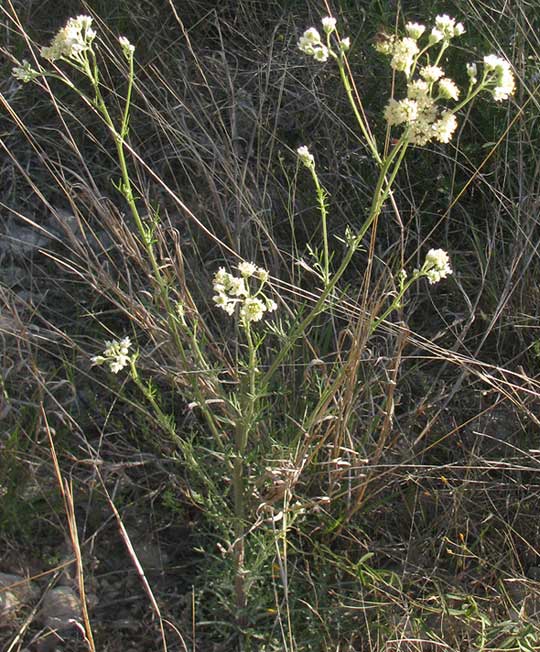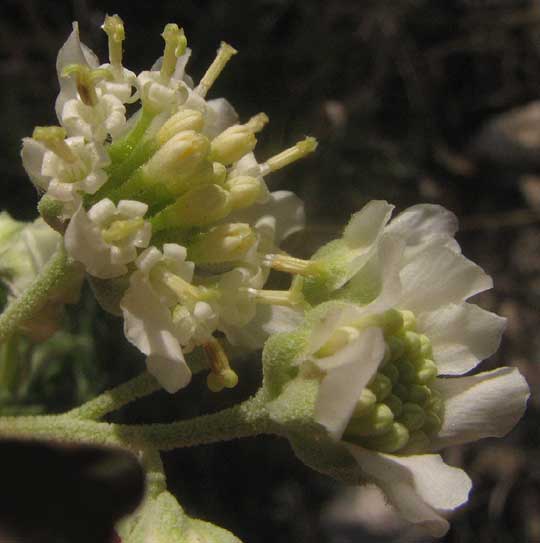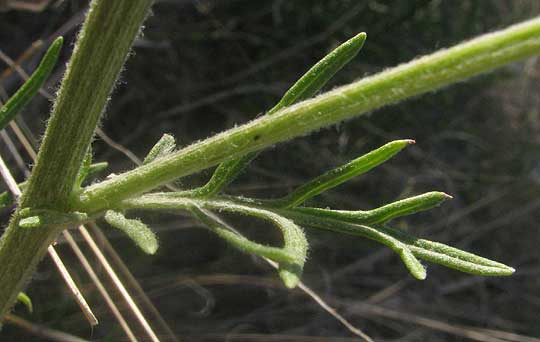Excerpts from Jim Conrad's
Naturalist Newsletter
from the May 11, 2014 Newsletter issued from the Frio Canyon Nature Education Center in the valley of the Dry Frio River in northern Uvalde County, southwestern Texas, on the southern border of the Edwards Plateau; elevation ~1750m (~5750 ft); N29.62°, W99.86°; USA
CHALK HILL WOOLLYWHITE
Along a sand road across the Dry Frio's gravelly floodplain a wildflower managed to develop green leaves and flowers despite the awful drought we're having. Below, you can see it surrounded by brown, dry-crisp grass:

It's a member of the Composite or Sunflower Family, as is clear when we see its tiny florets clustered in bunches, with each cluster held inside a bowl-shaped, calyx-like "involucre" consisting of scale-like modified leaves, or phyllaries, as seen below:

Unlike typical members of the Composite Family, however, this plant's phyllaries, while green at their bases, flair into large, white, petal-like wings, making it seem as if the flowering heads are composed of both tiny disk flowers in their centers, and petal-like ray flowers along the margin, like a typical daisy. However, these flowering heads bear only cylindrical disk flowers. A closer look at a couple of heads showing the situation appears below:

The plant's shape and unusual flower configuration is very much like the Old Plainsman wildflower, Hymenopappus scabiosaeus, we saw last summer. However, that species flowered later, when it was quite hot, plus back then I saw the Old Plainsman only in thin soil atop limestone bedrock, so could this be a second, earlier-blooming species? You can compare our present plant with the Old Plainsman at http://www.backyardnature.net/n/h/hymenopa.htm.
It turns out that this is indeed a second Hymenopappus species. The easiest-to-see difference between the two species is in the compound leaves, whose lobes are very narrow in the present species, shown below:

Mostly this wildflower is known as the Chalk Hill Woollywhite or Chalk Hill Hymenopappus. Its HYMENOPAPPUS TENUIFOLIUS, endemic to the US central prairie states from South Dakota to about here. The "chalk hill" in the names refers to the species' affinity for limestone hills, though it also occurs in lowland sandy, gravelly, and silty soils, where we found it.
One reason our plant can issue green leaves and flowers during our severe drought is that Chalk Hill Woollywhite is a biennial. Last year it developed a nice taproot that now draws moisture from deep in the soil, plus it spent the winter as a rosette of leaves storing energy for this spring's big push, whether there was much rain or not.
It's always a special pleasure to find another species of a genus I'm already familiar with. It's the "variations on a theme" phenomenon, a process that's powerful not only in the field of music, but in nature-sleuthing as well.